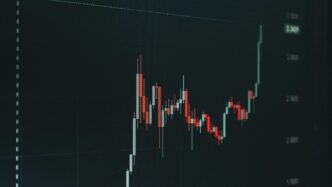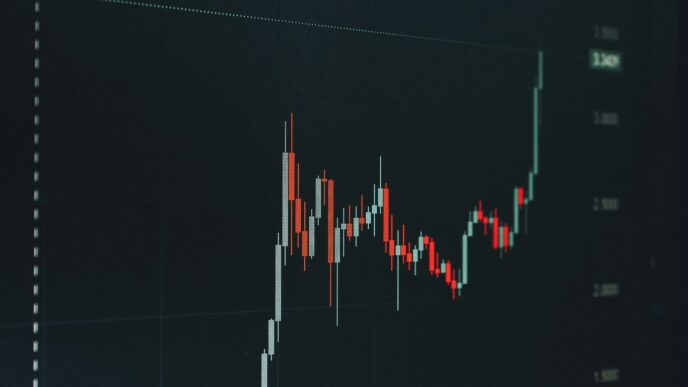It seems like every year, the financial world in Asia-Pacific gets a little more complicated, and 2025 is no different. Bloomberg APAC has been right in the middle of it all, tracking everything from central bank moves to the wild swings in gold demand. With interest rates bouncing around, new rules coming in, and investors looking for safer places to park their money, there’s a lot to keep up with. Bloomberg APAC’s data and insights have become a go-to for anyone trying to figure out where things are headed next, whether you’re in Tokyo, Mumbai, or Sydney.
Key Takeaways
- Bloomberg APAC is closely following how central banks in Asia-Pacific are reacting to global uncertainty, with interest rates likely staying high and cuts happening slowly.
- Money market funds and ultra-short strategies are gaining popularity as investors look for safer, more flexible options in a volatile environment.
- Gold demand in APAC is booming, with both retail and institutional investors turning to gold-backed ETFs and other products for stability and diversification.
- Policy changes in countries like India and Japan are making it easier for people to invest in gold and other financial products, encouraging more participation from both individuals and institutions.
- Local factors, like China’s economic slowdown and Hong Kong’s recovery, are shaping investment decisions just as much as global trends, making Bloomberg APAC’s regional coverage especially important.
Bloomberg APAC’s Insights on Central Bank Policies and Interest Rates
Navigating Market Volatility Amid Global Uncertainty
If there’s one thing investors hate, it’s surprises, and central banks in the Asia-Pacific region have had their hands full. With geopolitical risks rising and trade tensions showing no signs of easing, policy decisions have been tough. Most central banks across Asia, like those in India and Indonesia, have held back on rapid rate cuts because inflation—while down from its peak—hasn’t cooled as quickly as everyone hoped.
These are some of the market realities driving current volatility:
- Inflation is easing but sticky service costs keep pressure on rates.
- Yield curves have flattened, making longer-duration bonds less attractive.
- Economic growth in some countries (China, Australia) is softer, so central banks are walking a fine line between cutting rates too soon and risking inflation coming back.
Here’s a comparison of base rates across key APAC economies (end-2024):
| Country | Policy Rate (%) | Last Rate Action |
|---|---|---|
| Japan | 0.25 | Hike in late 2024 |
| Australia | 4.35 | Hold |
| Singapore | 3.60 | Hold, potential easing |
| China | 2.50 | Cut expected |
| Hong Kong | 5.75 | Tied to US rates |
Influence of Federal Reserve on Regional Monetary Strategies
The Federal Reserve still sets the tone for lots of APAC’s central banks. If the Fed cuts rates, countries like Hong Kong almost have to follow because of their currency pegs. Even for places like Australia, what the Fed does feeds into market expectations and local yields.
Key points on how the Fed shapes regional decisions:
- Hong Kong’s rates follow the Fed very closely due to the currency peg.
- Australia and Singapore track US policy mainly through market pricing and bond yields.
- China has a freer hand, but still feels pressure if US dollar liquidity tightens or loosens.
So, everyone’s watching Jerome Powell—and even the local headlines seem to take cues from Fed meetings.
Implications of Data Dependency for Investors
Data dependency is the buzzword for 2025: central banks say they’ll wait for the numbers before making each call. That sounds good in theory, but the data can be—and often is—wrong or misleading. Investors are left reading between the lines.
Here’s what investors need to keep in mind right now:
- Central banks are cautious, so moves will be gradual and possibly reversed if new data shifts.
- Market volatility will likely linger as every new inflation or jobs report has the power to move yields.
- Money market and ultra-short duration strategies look safer. Chasing longer-term yields in this climate can backfire if rates shift unpredictably.
If you’re putting cash to work in APAC, don’t expect the smooth ride of years past. Cautious optimism and quick reactions to central bank talk are the name of the game in 2025.
Regional Investment Trends Driven by Bloomberg APAC Analytics

Asia-Pacific’s investment scene in 2025 just refuses to sit still. Bloomberg APAC analytics have been tracking every shift, every new idea, and honestly, there’s a lot to untangle. Three themes keep popping up across the board: cash is king again in money market funds, the whole yield curve thing is tripping up long-term strategies, and asset allocation? It keeps moving around depending on which country you look at.
Rise of Money Market and Ultra-Short Duration Strategies
Growing uncertainties in global markets have pushed a flood of assets into money market and ultra-short strategies. Investors are keeping things liquid and not taking big risks on duration. According to Bloomberg’s data, cash investments are up sharply — it’s a trend that’s been hard to ignore.
- Investors are seeking safety because rate cuts are expected, but it’s unclear when they’ll arrive.
- High real yields on near-cash products are attracting cautious investors.
- Portfolio managers now see money markets as more than just a parking space; they’re core holdings.
| Year | Money Market AUM (USD bn) | YoY Growth (%) |
|---|---|---|
| 2023 | 1,580 | 8.2 |
| 2024 | 1,730 | 9.5 |
| 2025* | 1,860 | 7.5 |
*Source: Bloomberg Finance L.P., June 2025
Yield Curve Flattening and Duration Management
The APAC region’s yield curves have shifted over the last year — they’ve basically flattened, which is causing headaches. If you’re thinking about “going out the curve” for a bit more yield, you’re probably realizing it’s not worth the extra risk right now.
- With rates at multi-decade highs and expected to fall, locking in longer maturities looks risky.
- Short-duration bonds offer nearly the same yields as longer bonds, with less pain if things turn sour.
- Bloomberg APAC’s data shows aggressive flows out of long-dated debt and into shorter maturities since late 2024.
Shifts in APAC Asset Allocation Preferences
Asset allocation is a moving target in APAC these days. Countries are reacting to their own economic pressures, with some tilting more to cash and bonds, while others sniff around equities or even alternatives.
- Chinese investors, spooked by growth worries, have scaled back on risky assets.
- Japanese funds are still sticking with domestic bonds, despite the low rates, due to political uncertainty.
- Australia and Singapore continue searching for global opportunities, with a particular eye on high-quality short-term credit.
So, Asia-Pacific isn’t simply copying global trends — it’s putting its own spin on portfolio choices. Watching these trends as they show up in Bloomberg APAC’s analytics helps investors avoid getting caught off guard.
Acceleration of Gold Investment and Portfolio Diversification in Asia-Pacific
Gold investment is getting a lot of attention across the Asia-Pacific region this year. Whether you’re checking out ETF flow stats or looking at physical gold, the shift feels impossible to ignore. Some call it a reaction to choppy markets and currency swings, but for many in Asia Pacific, owning gold is becoming a common portfolio move—far more than just tradition or a trending trade.
APAC’s Dominance in Global Gold Demand Expansion
By mid-2025, APAC is on track to make up 69% of global gold demand—well above any recent average (Asia-Pacific region is expected to account for 69% of global gold demand). That’s a leap from past years, when the region’s share dipped during the height of global lockdowns. These days, inflation, stock market wobbliness, and worries about local currencies keep pushing investors—big and small—toward gold.
Here’s a quick table for context:
| Year | APAC Share of Global Physical Gold Demand |
|---|---|
| 2020 | 39% |
| 2019 | 64% |
| 2025 (est) | 69% |
What does this mean in practice?
- APAC gold buyers are less spooked by US Fed decisions; their motives are grounded in local realities
- Governments in India, China, and Japan have rolled out policies that make gold ownership easier and sometimes more attractive
- Central banks and big institutions are increasingly treating gold as a serious strategic asset
Bloomberg APAC Coverage of Gold-Backed ETFs Surge
It’s not just about coins and bars. Bloomberg APAC has been following a huge spike in gold-backed ETFs, especially since 2020. Places like Australia got the ETF ball rolling years ago, but in 2025, APAC funds are now holding a record 368 tons of gold—that’s about 10% of all gold ETF holdings worldwide.
A few reasons for this ETF rush:
- Nervousness over inflation and shaky currencies in places like Japan and China
- Retail and institutional investors both want an easier way to access gold
- Reforms (like new tax breaks in Japan and India) mean ETFs are more attractive than before
Breakdown of recent gold ETF flows in APAC:
- From 2020 to 2023: Net annual inflows averaged $478.6 million
- 2024: Inflows surged to $1.89 billion
- First half of 2025 alone: Already at $2.97 billion, with 83% going toward investment trusts and 17% toward ETFs
Role of Central Banks and Institutional Investors in Gold Markets
Central banks in Asia-Pacific have started treating gold less as a reserve relic and more like a major strategic holding. It’s not just public sector players—institutions, intermediaries, and retail buyers all see gold as a proven insurance policy.
Why are central banks buying more?
- They’re hedging against currency shocks and global dollar swings
- Gold helps buffer portfolios in regions packed with economic surprises
- Regulatory efforts (lower import duties, easier ETF access) are fueling demand
The shift isn’t a short-lived trend—it’s a sign that attitudes in APAC are changing. When about a quarter of the region’s asset owners report no gold holdings, but over a quarter want to increase their allocation soon, that says a lot about what’s ahead for Asia-Pacific gold markets in 2025.
Impact of Policy Reforms and Regulatory Changes on APAC Financial Markets
Asia-Pacific has really shaken things up with new policy shifts and regulations, and it’s not just talk—these changes are remaking how investors and markets work day-to-day. Government action on everything from gold taxes to retail investment is carrying serious weight for everyone involved. Let’s break down some of the bigger moves from the past year.
India’s Pro-Gold Reforms and Reduced Duty Structure
India took bold steps starting in July 2024 to make gold ownership more cost-effective and appealing. The government slashed gold import duties from 15% to 6%, the lowest in over a decade. Gold doré also saw a cut, from 14.35% to 5.35%. There’s more—a new, lower tax rate for long-term capital gains (12.5% without indexation, down from 20%) and a shorter required holding period (now 24 months) for those gains.
Key developments in India’s gold market:
- Lower import and doré duties stimulate local gold industry activity.
- New capital gains rules increase after-tax returns for investors.
- From April 2026 onward, ETFs and mutual funds holding gold will enjoy better tax treatment.
All these tweaks are set up to bring more investors into India’s formal gold market, nudging the industry toward financial innovation via fintech as well.
Japan’s NISA Scheme Boosting Retail Investment
Japan embraced reform, too. The new NISA scheme—similar to the UK’s ISA—upped the annual tax-free investing limit to JPY3.6 million, removed time limits, and made tax breaks permanent for holdings up to JPY18 million. Even gold trusts and ETFs qualify, so regular savers now have more types of investments to choose from.
Benefits for Japanese investors:
- Bigger tax-free allowance encourages people to move cash out of low-yield bank accounts.
- Gold and other non-traditional assets now included in the tax-advantaged bracket.
- The NISA shake-up targets "idle" savings and steers it toward investment, which should help boost liquidity and diversification.
Bloomberg APAC Tracking of Hong Kong’s Gold Hub Initiatives
Hong Kong isn’t sitting still. In October 2024, officials announced a multi-part plan to reposition the city as a top-tier global gold trading hub. Their approach features:
- Expanding vault space for gold storage, so there’s room for more bullion.
- Upgrading trading and settlement infrastructure, which should reduce bottlenecks and costs.
- Tightening regulations to make gold trades safer for everyone involved.
They’re also focused on tighter links between Hong Kong and mainland China—deepening cross-border gold trade and reinforcing the city’s role as a financial gateway. For context, the next phase sees more gold-backed products and new cross-market channels opening up, which Bloomberg APAC is keeping a close eye on.
Table: Key 2024–2025 Policy Reforms Affecting APAC Financial Markets
| Country | Policy Change | Key Impact |
|---|---|---|
| India | Lowered gold import duties | Boosts gold demand, lowers costs for investors |
| India | New capital gains tax rule | Makes investing in gold more tax-efficient |
| Japan | Expanded NISA scheme | More tax-free investing, gold included |
| Hong Kong | Gold hub strategy & infrastructure | Increases storage, links with China, stronger oversight |
- Each of these policy moves makes financial markets in APAC a bit more dynamic.
- They help retail and institutional investors seek out new opportunities for growth (and sometimes safety).
- Whether through higher gold allocations, new savings vehicles, or improved regulatory systems, the region is clearly trying to adapt to a world in flux.
There’s no doubt—2025 is proving to be a year when old habits get tossed aside and fresh, sometimes surprising, opportunities open up for the Asia-Pacific investment crowd.
Market-Specific Drivers and Challenges Across Key APAC Economies

Asia-Pacific is never boring; every market has its quirks, shocks, and surprises. This year, some familiar giants are again steering the ship—especially China and India. Let’s break down what’s moving the needle across a few of the region’s biggest economies.
Chinese and Indian Demand Shaping Commodity Flows
China and India have a massive footprint in the global commodities space, especially gold. Their combined demand in the first half of 2025 made up over half the world’s gold bar and coin purchases, a jump from 39% in 2020. What’s pushing this surge?
- China: Investors are shifting towards gold as property and equity returns disappoint. Persistent policy worries keep folks on edge, so many turn to gold as a safe spot for their money.
- India: Steady growth, rising incomes, and a weak Rupee continue to boost household appetite for gold. It’s still seen as a reliable store of value and an important cultural asset.
- Ongoing: Both countries’ growing middle classes are fueling more diversification—which trickles down to other commodities too.
Table: Gold Bar & Coin Demand in China and India (2020 vs 2025)
| Year | Global Gold Demand (%) | China + India Share (%) |
|---|---|---|
| 2020 | 100 | 39 |
| 2025 | 100 | 53 |
Hong Kong’s Economic Recovery and U.S. Rate Dependence
Hong Kong’s economy started to look up in mid-2025 as inflation stayed low and activity picked up slightly. But the city is very tied to US monetary policy—thanks to the HKD peg. Here’s the situation in plain terms:
- Local interest rates move in sync with the US, not because of what’s happening on the ground in HK.
- A break in US rate cuts could slam Hong Kong’s recovery—especially real estate and retail.
- Trade and tourism are still much weaker compared to pre-pandemic days, leaving the city vulnerable.
Hong Kong’s fate this year depends as much on decisions in Washington as in its own government offices. That’s been a tough pill for investors and policymakers alike.
Japan’s Interest Rate Outlook and Political Uncertainty
Japan stands out this year. Unlike its neighbors, the Bank of Japan actually lifted rates—twice—in 2024, hitting 0.25%. But higher rates don’t tell the whole story:
- Improvement in growth plus stickier inflation has squeezed household budgets, so talk of further hikes is complicated.
- Wages aren’t climbing fast enough to keep up with prices.
- National politics are as shaky as ever, making it hard to predict if and when the Bank of Japan will act again.
It’s a confusing mix. Monetary policy could shift again, but political drama might slow things up. Japanese investors are watching closely—and many are keeping some cash on the sidelines until things get clearer.
Key Takeaways:
- China and India are setting global trends in commodities, especially gold.
- Hong Kong’s economic path is basically chained to US rate moves, making its outlook fragile.
- Japan faces a tough balancing act with rates, inflation, and uncertain politics.
Markets across the region are getting pushed and pulled by global forces, but every economy here has its own set of complications. Bloomberg APAC’s coverage will keep tracking these localized twists, giving investors context that’s hard to find anywhere else.
Broadening Access to Financial Products in the Asia-Pacific Region
The way people invest and access financial products in Asia-Pacific is changing fast. In 2025, a few trends are really making a difference: more retail investors are getting involved, new investment vehicles are popping up, and there’s a move toward making things simpler and more accessible—especially for first-timers.
Growth of Gold Investment Trusts and ETFs in Japan
Japan’s efforts to channel household savings into investments saw a big shift this year. The revamped NISA scheme (kind of like the UK’s ISA) expanded tax-free investing to cover gold ETFs and gold investment trusts. Now, individuals can stash up to JPY18 million tax-free, and there’s no time cap. This is important in a place where ordinary folks have trillions of yen sitting in the bank earning basically nothing. More retail investors are looking at:
- Gold as a simple, inflation-proof option
- ETFs for their lower costs and easy access
- Trusts, which give less-experienced investors a managed way to get exposure
Here’s a quick look at how the NISA cap has changed:
| NISA Type | 2023 Cap (JPY million) | 2025 Cap (JPY million) | Time Limit | Asset Coverage |
|---|---|---|---|---|
| General NISA | 1.2 | 2.4 | Removed | Equities, ETFs, Gold Trusts |
| Growth Category | 1.2 | 3.6 | Removed | Wider selection, including gold |
Innovation With Depository Receipts in Thailand
Thailand made a big leap by expanding depository receipts (DRs) on its main exchange. In plain language, DRs let Thai investors buy shares (or ETFs—even ones backed by gold) listed in other countries, but they’re traded locally, just like any other stock. For regular people, this means:
- You can get exposure to global assets without dealing with offshore brokers
- Fees are transparent, and DRs are easy to buy or sell
- Regulatory protections are in place, reducing the chances of nasty surprises
In 2025, Thai DRs tracking top global gold ETFs have attracted solid interest, and not just from big investors. Many people who want some gold in their portfolios—without actually storing gold—now have a practical option.
Institutional Participation via New Chinese Investment Programs
China’s trying new things too. The government recently let local insurers invest a small percent of their portfolios in gold. While it doesn’t sound like a huge change, it’s a new way for institutions to broaden their investments, especially when local property and equities feel shaky.
Some drivers behind the broader access in China:
- Capital controls limit other options, making gold more interesting
- Interest from the central bank is pushing institutions to add gold
- Policy pilot programs pave the way for future expansion if things work out
The table below summarizes the latest Chinese policies:
| Policy Change | Effective Date | Who Benefits | Gold Allocation Limit |
|---|---|---|---|
| Insurers allowed to hold gold assets | Feb 2025 | Domestic insurers | 1% of total assets |
| Central bank expanding gold programs | 2025+ | Institutions, market | To be announced |
Overall, these moves are giving more people—whether small retail investors in Japan and Thailand or institutional giants in China—a chance to get involved with new financial products. The region’s financial markets used to be seen as hard to break into, but that’s changing quickly. Even if you’re new to all this, it’s never been easier to get started, no matter your budget or expertise.
Conclusion
So, looking at everything happening in 2025, it’s clear that Bloomberg APAC is right in the thick of things when it comes to shaping financial trends across Asia-Pacific. With all the ups and downs—rate cuts, gold demand, new policies, and the constant push and pull from global events—investors and markets are moving fast to keep up. Bloomberg’s data and insights are helping people make sense of it all, whether they’re in Tokyo, Mumbai, or Sydney. The region’s appetite for gold, the changes in interest rates, and the steady stream of new investment products show just how quickly things can shift. If there’s one thing to take away, it’s that APAC’s financial scene is anything but boring, and Bloomberg is making sure everyone has the info they need to stay ahead. As we head further into 2025, it’ll be interesting to see what comes next—and you can bet Bloomberg will be right there, tracking every twist and turn.
Frequently Asked Questions
How does Bloomberg APAC help investors understand central bank policies in Asia-Pacific?
Bloomberg APAC offers clear, real-time updates on what central banks are doing with interest rates and policies. This helps investors see how global events, like changes in U.S. interest rates or local economic news, might affect markets in Asia-Pacific.
What are the main investment trends in APAC for 2025, according to Bloomberg APAC?
In 2025, Bloomberg APAC reports that money market funds and ultra-short-term investments are getting more popular. Many investors are also looking at different ways to manage risk as interest rates stay high and yield curves flatten.
Why is gold becoming more important for investors in Asia-Pacific?
Gold is becoming a top choice because it can protect against uncertain markets, inflation, and changes in local currencies. Many people and institutions in Asia-Pacific are buying more gold and using gold-backed ETFs to make their portfolios safer and more balanced.
How are government changes in countries like India and Japan affecting investments?
Recent changes, like India lowering gold import taxes and Japan making it easier to invest through the NISA scheme, are making it simpler and more attractive for people to invest in gold and other financial products. These changes are meant to help more people grow their savings and invest for the future.
What challenges do investors face in key APAC markets like China, India, and Hong Kong?
Investors in China and India are dealing with things like slower economic growth, changes in demand for goods, and currency ups and downs. In Hong Kong, the economy is getting better, but it still depends a lot on what the U.S. does with interest rates.
How is access to financial products changing in the Asia-Pacific region?
It’s getting easier for people to invest in things like gold ETFs, investment trusts, and depository receipts. New programs in countries like China, Japan, and Thailand are helping more people and institutions join the market and find new ways to invest.














